Lieutenant General Sir James Andrew Harcourt Gammell KCB DSO MC DL
1892-1975
James Andrew Harcourt Gammell was the eldest son of Sir Sydney James Gammell of Countesswells and his wife Alice Stobart. He was born in Edinburgh on 25 September 1892. At the age of 9, he was sent to a Preparatory Boarding School - Ardvreck, Crieff, Perthshire, and remained there until he entered Winchester College in the autumn of 1905. There he reached the 6th Form, and represented the School at Football before leaving in the summer of 1911 to go to Pembroke College, Cambridge as an undergraduate in the autumn of the same year. At Cambridge, he read History, and graduated with a 2nd Class Honours Degree in the summer of 1914.
Some time before leaving Cambridge, he had decided to make the Army his career, and joined the University O.T.C. and the Scottish Horse Yeomanry. He was accepted as a University Candidate by the Army under date of 19 December 1912, to be 2nd Lieutenant in the Royal Artillery, but not to carry pay and allowances until 5 August 1914 (which date turned out to coincide almost exactly with the date on which the 1st World War broke out).
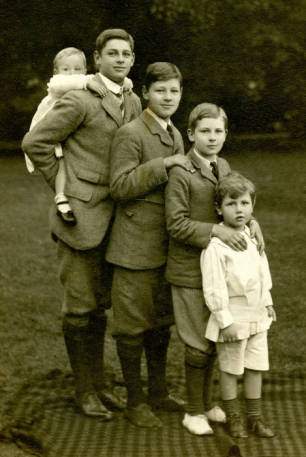
James in about 1909, with his brothers, Harry, Dick, William and Edward (being carried on James' back)
Almost immediately after taking up his duties with the Royal Artillery, he found himself in the firing line in France, the exact date of his embarkation being 20 August 1914. He was awarded the Military Cross early in 1915 for gallantry at La Bassée, returned to England soon afterwards, and was appointed to the Expeditionary Force being prepared for the assault on Gallipoli. He served throughout the Gallipoli campaign, and was twice Mentioned in Despatches. After the Gallipoli campaign ended, he was posted to Egypt, to join General Allenby, who was preparing for his campaign against the Turks. James was appointed G.S.0.3 to the Allenby Forces in December 1915, and G.S.0.2 to the same force in December 1916. He was promoted to full Lieutenant in June 1915, temporary Captain in February 1916 (full Captain December 1916), and Acting Major in September 1917, on which date he was also appointed a Battery Commander, still in the Middle East.
In the summer of 1918 he returned to Europe and after a short secondment to the Royal Air Force for observer duties, he was appointed G.S.0.2 at the War Office as from October 1918, a post he retained until the summer of 1921. During the war he was wounded more than once and was hit in the chest by a bullet, but saved by a cigarette case that he was carrying in his breast pocket. While serving in the Senussi Campaign in the Middle East in 1917, he had been awarded The Distinguished Service Order, and Mentioned in Despatches at least 3 more times. He was also awarded the Serbian Decoration of The Karageorge 4th Class with Swords, and the Order of the Crown of Italy 5th Class.
In 1921, James entered the Army Staff College at Camberley and having successfully completed his course there, was appointed G.S.0.2 Aldershot Command in May 1924. In 1927, when his Aldershot Command appointment came to an end, he transferred from the Royal Artillery to The Queens Own Cameron Highlanders, largely due to the lack of promotion prospects in the Artillery, and was granted the rank of Major with effect from 25 May 1927. After serving nearly 2 years with the 2nd Battalion in Edinburgh, he was posted to the 1st Battalion which was stationed at Rangoon in Burma and served with them until he was recalled to England, and appointed Instructor at the Staff College at Camberley with effect from January 1930, with the rank of Acting Lt. Colonel. When his 3 year appointment at the Staff College came to an end, James returned to Regimental duties, initially at Aldershot, and from May 1935 when he was promoted to the substantive rank of Lt. Colonel, as Colonel of the 1st Battalion, which was stationed at Khartoum in the Sudan, and afterwards at Catterick in Yorkshire.
On 7 June 1919, James had married at St. Peter's, Cranley Gardens in the West End of London, Gertrude Don, elder daughter of Gilbert William Don of Ravensby, Carnoustie, Angus, and partner in the firm of Don Bros, of Forfar, Jute Manufacturers. Owing to military commitments, James and his wife lived in a variety of houses in the Aldershot area, including Ringmore, Camberley; The Beeches, Farnborough; Cranbrook House, Aldershot, until finally settling at The Rowans, Camberley, which was their home until they moved to Scotland at the end of the 2nd World War.
James and "G" had four children as follows:
|
|
|
|
|
James Gilbert Sydney |
4 March 1920 |
|
|
John Frederick |
31 December 1921 |
|
|
Mary Finella |
15 April 1924 |
|
|
Elizabeth Alice |
22 April 1926 |
|
Both sons were educated at Winchester College, and the 2 daughters also received Boarding School education.
In 1938, after attending a course at The Imperial Defence College in London, James was appointed to command the 4th Infantry-Brigade, with the Temporary rank of Brigadier, having been gazetted full Colonel in the same year. In 1940 he was on the General Staff, and was Chief of Staff to General Auchinleck in the abortive Norway expedition in the summer of that year.
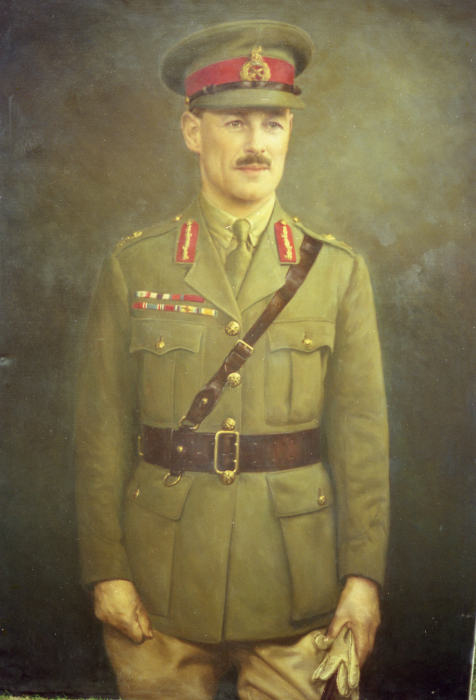
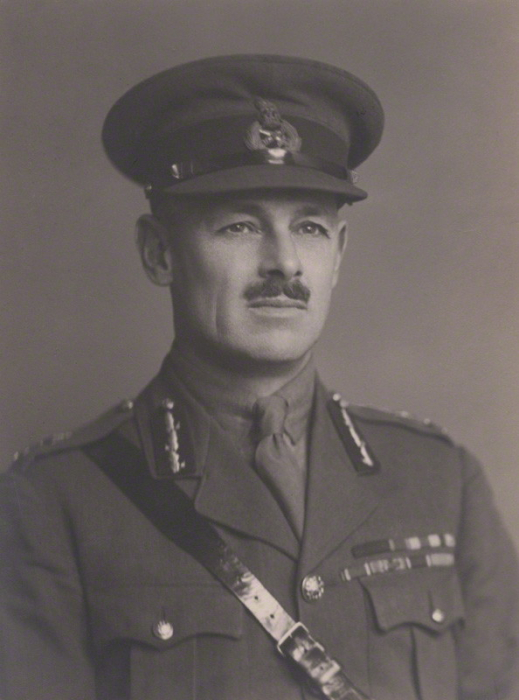
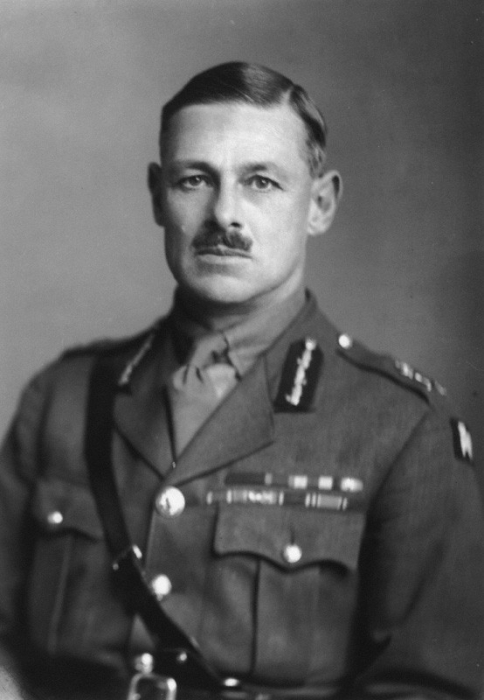
In July 1940, on his return from Norway, he was appointed to command the 3rd Division with the acting rank of Major General, and in May 1941, on promotion to substantive Major General, he took command of 12th Corps. Both these appointments were to units stationed in Southern England, at a time when invasion by German Forces appeared imminent, and were a tribute to the high opinion held of his ability. At the beginning of 1942 he was raised to the rank of Acting Lt. General, and appointed General Officer Commanding Eastern (England) Command, one of the most important posts in the country. This position he held until early in 1944, when he became Chief of Staff to The Supreme Allied Commander Mediterranean, Field Marshall Sir Henry Maitland Wilson, and was thus chiefly responsible for the plans for the invasion of Southern France to coincide with the Normandy Landings in the summer of that year.
Above: Official portraits 1942 - National Portrait Gallery.
Below: Photo from 1942
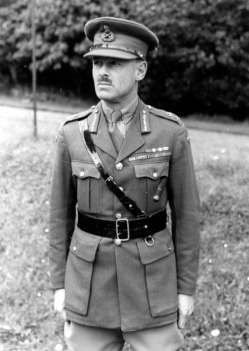
In the early part of 1945, when the Mediterranean campaign was virtually completed, James returned to England, and after the surrender of Germany in May of that year, was sent to Moscow as head of the British Military Mission to the U.S.S.R., where he remained until he vacated that post in October 1945.
He had been appointed Commander of The Bath in 1940, created a Knight of The Bath in 1944, attained the rank of full Lieutenant General in that same year. Besides the honours and decorations he was awarded by his own country, he was also appointed a Commander of the Legion of Merit by the Government of the United States of America, and awarded the Order of the White Lion by the Czecho-Slovak Government and the Order of Military Merit by the Government of Brazil; all these in recognition of his services to their countries during the 1939/45 war.
He thus had every reason to feel satisfied with what can only be described as a brilliant military career, spread over some 32 years and since there seemed to be few military fields left to conquer, he decided to apply for retirement with effect from 9 May 1946.
In 1943, James had purchased from his brother-in-law Eric Ivory of Brewlands in Glenisla, Angus, the property of Alrick, which lies also in Glenisla, and adjoins the Brewlands estate. The property consisted of the house, possibly better described as a shooting lodge, together with a hill farm, the whole amounting to some 1000 acres. James and his wife moved into the property on his retirement, and set out on the task of making a home for themselves and their family, and a viable farming unit out of the land.
In 1946, on the death of his father Sir Sydney Gammell, James fell heir to what remained of the Gammell estates - namely the estate of Countesswells just outside the town of Aberdeen, but James and his wife had, sometime previously, ruled out the possibility of living there. The house was rambling and inconvenient, and the position of the property generally did not compare with that which they had acquired in Glenisla. James therefore decided to sell up and sever the last Gammell connections with Aberdeenshire. The Mansion house was sold to the sitting tenant, the farms sold off gradually to tenants as opportunity offered, and the woods and moorland made over to the Forestry Commission. With part of the proceeds of these sales, James was able to purchase more land in Glenisla from the Earl of Airlie plus the small property of Little Forter, thus completing a compact unit, and bringing the total acreage of the estate to approximately 3000 acres.
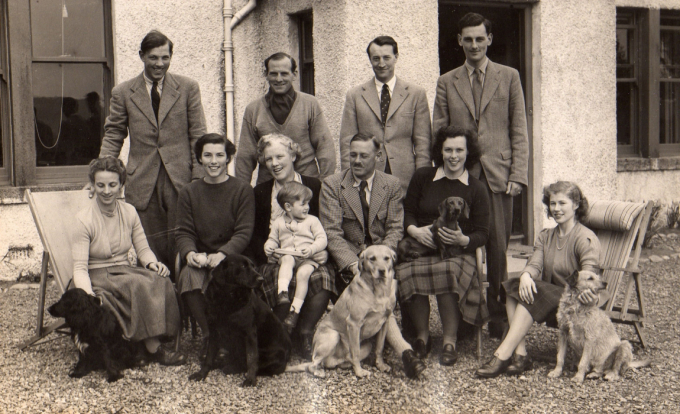
James with his family at Alrick in about 1948. From left to right, Meg and John Gammell, Mary & Jamie Stomonth Darling, "G" with her grandson Jamie on her knee, Lt Gen Sir James Gammell, Mervyn and Elizabeth Dalley, Jimmy and Sue Gammell
James was keenly interested in the economics of modern hill farming; he reclaimed much marshy ground, planted numerous shelter belts to protect his stock, and was a pioneer in the reseeding of heathery hillsides with clover and grass, thus providing a vast increase in the number of animals the land could sustain. By the time all the improvements at Alrick had been completed, the estate was capable of carrying some 1000 ewes plus 150 head of cattle, as well as providing at least some of the fodder necessary to maintain this stock in winter.
In 1960, while on holiday in South Africa, James lost his wife "G", who died suddenly as a result of a severe heart attack while they were touring South Africa by car. She was cremated in South Africa, and her ashes brought back to Scotland and buried at her beloved Alrick. James continued to live at Alrick, and run the estate, but in 1962 Alrick was very seriously damaged by fire. After much thought, James decided that the best solution was the demolition of the whole house other than the West Wing which was undamaged, and reconstruction from scratch in a more modern style. This he accomplished with very great success, and Alrick now stands, as a modern and convenient house, on what must be quite one of the outstanding sites with its breath-taking views, in the whole of Glenisla.
On 8 February 1964 James married Mary Kirkwood in Bath. Mary was his first cousin and widow of Commander D.R.M. Kirkwood, Royal Navy and only daughter of J.G. Russell Harvey of Bristol and his wife Eleanor (nee Stobart). James and Mary lived a very happy and full life in the glen, James busy with his estate interests and Mary busying herself with improvements in the layout of the garden, with the interests of the population of the glen and with a constant stream of visitors, especially in the summer, when the glen and garden were at their best. In later years James and Mary spent increasing time in a small house at Abbotts Leigh just outside Bristol, but Alrick remained their home, and it was only to avoid the worst of the winter that they made their visits to the south.
By 1966/67, the estate was in good heart and James decided therefore that as he was getting on in years it was time he relinquished active management of his property, and so he arranged for the whole estate, excluding the house and immediate surroundings, to be run by his eldest grandson James (Jamie), who had reached the age of 21 and for several years had been engaged actively in farming under James' supervision, and had proved himself a keen and resourceful farmer. From that time on therefore James became the interested spectator of the development of the Alrick property, rather than the active instigator. This new role however in no way lessened his interest or enthusiasm for all that went on, and he and his grandson developed a very close and harmonious relationship, which continued right up to the time of James' death.
In 1973 James underwent a very serious abdominal operation from which he never really fully recovered, and which severely restricted his mobility. This bore hard on him, as he had been accustomed to a very active life, and nothing in the earlier years pleased him better than trudging his land, and showing off his achievements to visiting friends and relations. His wife tended and cosseted him with the greatest devotion, but James was worn out and perhaps it was a mercy that the end was not too long delayed. It was on 1 September 1975, just a few weeks short of his 83rd birthday that he died peacefully at Alrick with all his children and 4 of his grandsons with him. He was greatly mourned by all who knew him, not only his family and friends, but by the whole population of Glenisla for whom he had done so much. James funeral service was held in the Glenisla Church and was attended by many relations, friends and residents of the glen, who all came to pay tribute to a greatly respected and popular Scottish laird. A bible now displayed on the communion table was gifted to mark the occasion and is inscribed as such. Glenisla Church was closed by the Church of Scotland in 2013 and placed on the open market. A group including the Gammells was formed and the Church purchased and placed in a charitable Trust and gifted to the Glen for use in perpetuity. It is still run as a church and is open for services once a month, weddings and funerals, but to the great disappointment of the community, it is not allowed to conduct christening services which must be held in the Parish Church. For further information visit glenislachurch.org
He was cremated and his ashes buried at Alrick with those of his first wife, Gertrude. A granite stone etched with their initials and dates lies against a tree beside a bench looking up towards Mount Blair on the north side of "Granny's Wood" and overlooking the Doonies Burn.
James had been a Deputy Lieutenant for Angus since 1946, had been elected to the Angus County Council in 1949, and served as Chairman of their Finance Committee from 1955 to I965, at which date he also finally resigned from the Council. He was also Chairman for a time of the Kirriemuir District Council, and a fervent supporter of the Glenisla Hall Committee, which his first wife had done so much to encourage. Perhaps there is no better way of recording the extent of his influence on the glen than by quoting an appreciation published in the Dundee Courier at the time of his death:-
"While your obituary notice covered the distinguished Military career of James Gammell, it will be his 30 years of so-called retirement for which he will be remembered. These years of great activity were devoted to his county of Angus, to the Community of Glenisla and to his Church - both Presbyterian and Episcopalian.
In these days when service to the Community, especially in the remoter country areas, is so important, James Gammell's life and work should be recorded with deep gratitude. It stretched from the Chairmanship of the County's Finance and Police Committees to serving as Secretary for the new Village Hall - the envy of the neighbouring glens.
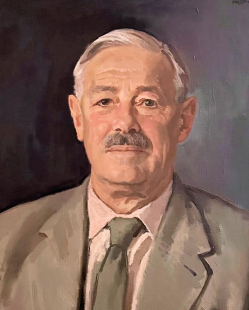
Not content with these responsibilities, he attacked the seemingly intractable land on the shanks of Mount Blair, and revolutionised the farming methods. Well-nigh worthless heather and rock soon smelled sweet with the scent of clover to the delight of his Black-faced sheep, and the bogs with the rushes were transformed into winter keep for cattle. His meticulous records were constantly used by students of hill-farming improving techniques.
This breath of life gave new hope to the glen which he loved so dearly. It brought stability and prosperity to those who live in it, and this above all else was his ambition, for he cared intensely for the well-being of all those for whom he had any responsibility.
His foresight and energy ensured a stimulating home base for his family, which expanded, to his great joy, unto the fourth generation. He has left a legacy of high standards as an inspiration to all who follow.
Throughout all these years he was supported by his first wife Gertrude Don, who died in 1960, and then by his widowed cousin Mary Kirkwood, who he married 4 years later. It was their love and devotion that created the family home as a "sure rock" and which made possible his exceptionally active and varied achievements in his so-called "retirement".
He always counted his blessings, and he died with thanks in his heart."
After James' death, his wife Mary left the glen, and went to live in the house at Abbots Leigh, just outside Bristol.
Jamie, James' eldest grandson, and the new owner of the Alrick estate, now lives at Alrick with his family.
In 1958, James petitioned for and was granted Arms by the Lord Lyon King of Arms as "Gammell of Alrick, Representative of Drumtochty", and thus acquired the same Coat as had been originally granted to his great-grand uncle Andrew Gammell of Drumtochty in 1841.
